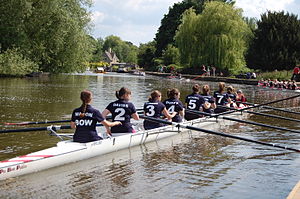We’re introducing a new section: Drills and Exercises for Rowingwhich will be a ready reference for coaches describing the exercises, their purpose and how to do them. We’ll also be giving tips as to best practice and suggesting variations and extensions as your crews get

Before we introduce this we found that we’d already made some assumptions about how you would use these. They are that you will:
- describe the exercise on land, before the crew gets on the water
- demonstrate how to do the exercise yourself and with at least one of the crew doing the same
- discuss with and especially draw from the crew what the effect on the boat and their rowing will be and why that’s desired
- use examples of crews doing this well, particularly if it was this crew (last session, last week, last race)
- talk about what they will see, hear, feel
- brief the coxswain and the crew as to how the exercise will be developed using part of the crew before the whole crew does it, whether there’ll be any rating changes, how many strokes of each sort and where and when you will do the exercise – sometimes it’s better to have this written down
Practicing exercises for rowing
On the water we also assume that you have chosen a place where the water is relatively still and calm, with little or no traffic and where you can get close to the crew so that they can hear your descriptions and see your demonstrative gestures.
We recommend that you build up to doing the exercise with the full crew. For example if you’re coaching an eight start in fours, move onto sixes and then into the eight together.
We like to put the exercise into context with the normal stroke by following the exercise with normal rowing or sculling so if you’re with an eight have the stern four do 10 strokes of the exercise and 10 strokes normal rowing before you move onto the bow four. After that try 10 strokes of exercise with the stern four before you bring in the whole eight rowing normally for 20 strokes to see how much of the change they can hold.
As a further test of their concentration it’s fun alternating single strokes: exercise, normal, exercise, normal or what about 2:1 – exercise, exercise, normal, exercise, exercise, normal.
We think it’s important to follow the exercise session with some steady rowing with you and your coxswain both focused on the aim of the exercise and giving feedback directly related to that. Be demanding but also react strongly to whatever is done well.
We expect the changes to be tested under different conditions: try the same actions at different ratings to see how much the change endures the closer you get to race pace or in rougher water, with the wind, against the wind, with another crew alongside . . .
We don’t expect all of this to be done in one session. This could take a week or longer built into your training programme, every day adding to the degree of difficulty, building skill levels. Allow time for the crew to develop. Trying to cram it all in means that the change isn’t complete, the boat doesn’t respond as well, the crew loses sight of what the exercise is for and then won’t be able to hold onto its effect in normal rowing or under challenging conditions.






